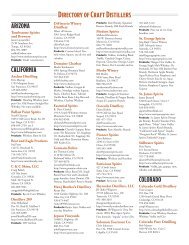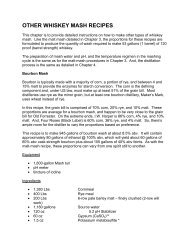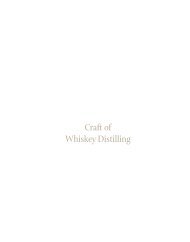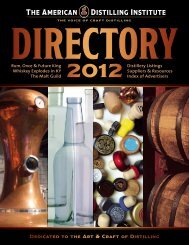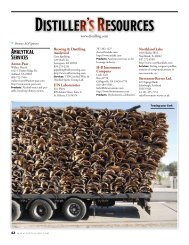CHAPTER 6 Building A Corn Cooker - The American Distilling Institute
CHAPTER 6 Building A Corn Cooker - The American Distilling Institute
CHAPTER 6 Building A Corn Cooker - The American Distilling Institute
You also want an ePaper? Increase the reach of your titles
YUMPU automatically turns print PDFs into web optimized ePapers that Google loves.
7. <strong>The</strong> wash will take between 5 to 10 days to ferment. Remember, as the<br />
wash ferments it will heat up. <strong>The</strong> goal here is to “hold” the fermentation below<br />
75 º F. High temperature fermentations produce off flavors that come through<br />
during distillation.<br />
8. When fermentation is finished, there will be no more bubbles.<br />
9. If using a plastic drum as a fermentation tank use a sump pump to move<br />
the wash into the still. In order to get the last five gallons of liquid out it will be<br />
necessary to tip the tank. Drain the liquid through a Ez Strainer, leaving behind<br />
the corn pulp. This liquid, which is about 5 gallons, goes into the still.<br />
Note:Remember never pump corn solids into a direct fired still it should be strained to<br />
keep out solids.<br />
10. Keep two log books: one on cooking and fermentation of the wash, the<br />
other log for distillation. It is very important to keep records so that you do not<br />
make the same mistakes twice.<br />
11. Distill the wash. Make a fast run stripping alcohol from the wash to<br />
produce a low wine of 25% alcohol. Distill the low wine a second time (double<br />
distillation) in order to get moonshine that is 65% abv.<br />
12. Clean up the mess. (Do not drink while driving a car or distilling alcohol).<br />
Note: With everything said and done and you insist on distilling corn whiskey do it<br />
the easy way using pregelatinized precooked corn. Take a brewing class and learn how<br />
to make wash from precooked corn. <strong>The</strong> recipe is 80% corn, 20% barley.<br />
A whiskey distiller often runs into the late (tail) fraction with head<br />
temperature reaching 202 º F at the high end. When aging whiskey<br />
tails are sometimes added back as they “soften” in the oak barrel.<br />
Adding tails to a clear moonshine or unaged whiskey is avoided as<br />
they contain esters giving the drinker a headache.<br />
32 Modern Moonshine Techniques



